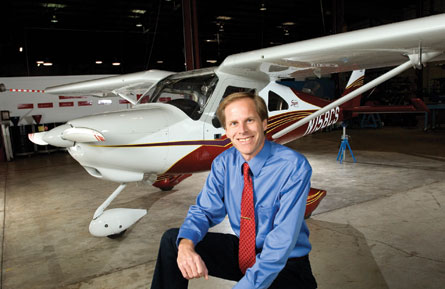Starting life in Toledo, Ohio and ending up in Wichita, Kansas, after stints at Boeing and NASA, project engineer Neal Willford takes some of Cessna's most important aircraft from concept to reality
Did you always want an aviation career?
In my pre-school days I wanted to be a garbage man when I grew up. Fortunately, my dad was involved in aviation, first as a corporate pilot and then heading the aircraft maintenance department for Dana in Ohio. I spent time at the hangar with him, as well as going to the Experimental Aircraft Association Fly In at Oshkosh. I also built a lot of model airplanes. My interest grew from those activities, but I was never pushed in that direction by my dad.
Compare Cessna with your A-6E wing work for Boeing or R&D testing at NASA
Being able to support the test activity for the A-6E and windtunnel R&D activity was interesting, but that was for aircraft that I would never be able to fly or ride in. Working on civil aviation projects gives me that chance.
What led you to apply at Cessna?
There were changes under way at Boeing Wichita in 1989 that indicated that the type of work I was involved with would be shifting to Seattle. About that time, Cessna announced that it was launching the model 525 CitationJet programme and was hiring engineers for that project, so I decided to work for Cessna instead of transferring to Seattle.
What's different between designing light aircraft and Citations?
Both bring different challenges and rewards. I worked on "jets" at Cessna from 1990 to 1995. That was pretty challenging and fun. Going on test flights on the Citation X at speeds over Mach 0.9 and watching the shock waves on the wing was a fun part of the job. I had the opportunity to transfer from the Citation X project to the single-engine restart effort in 1996.
Going from working on the Citation X to the 172 is quite a change, but I wanted to work on aircraft that I could be in a position to fly myself.
 |
|---|
©CessnaWillford was lead designer of the Cessna 162 Skycatcher |
What are the first design steps?
Al Mooney once said "they all fly through the same air", indicating that the laws of physics apply equally to each aircraft manufacturer. The designers take the set of performance targets and balance them against the aerodynamic, structural, propulsion and manufacturing requirements that would be needed to meet those targets. This can sometimes result in conflicting requirements, so the design and/or performance targets are revised to maximise the overall performance of the design.
What is most challenging?
I would say the most time-consuming is the detailed design phase. This is when all the different designers need to work closely together to flesh out the design. Strength, cost, weight and manufacturability all play a big role at this stage, and close co-ordination is required between the different engineering disciplines, as well as manufacturing, supply chain and product support.
How did computers affect your job?
Computers provide the ability to do more detailed analysis at a much faster pace than in the days of slide rules and hand calculations. Computer-aided design software allows the designers to accurately develop a new design. These tools help to determine potential interference issues within the design and provide accurate geometry that is, in turn, used to make tooling to manufacture the aircraft.
What's the best part of your job, and what could you do without?
The best part is working with a lot of talented people turning ideas into new aircraft that our customers will eventually take delivery of and enjoy using. The toughest part was having to participate in the difficult decision-making process regarding staffing reductions during the recent industry downturn.
Source: Flight International























